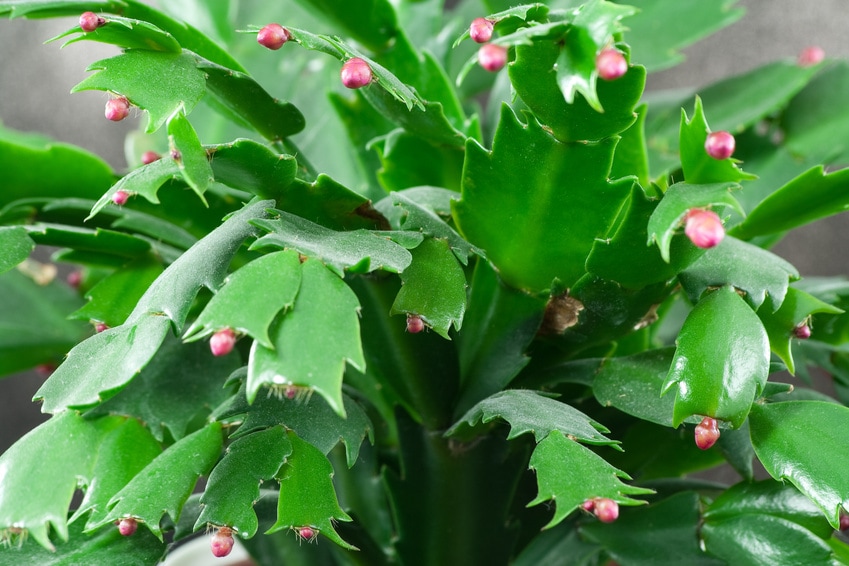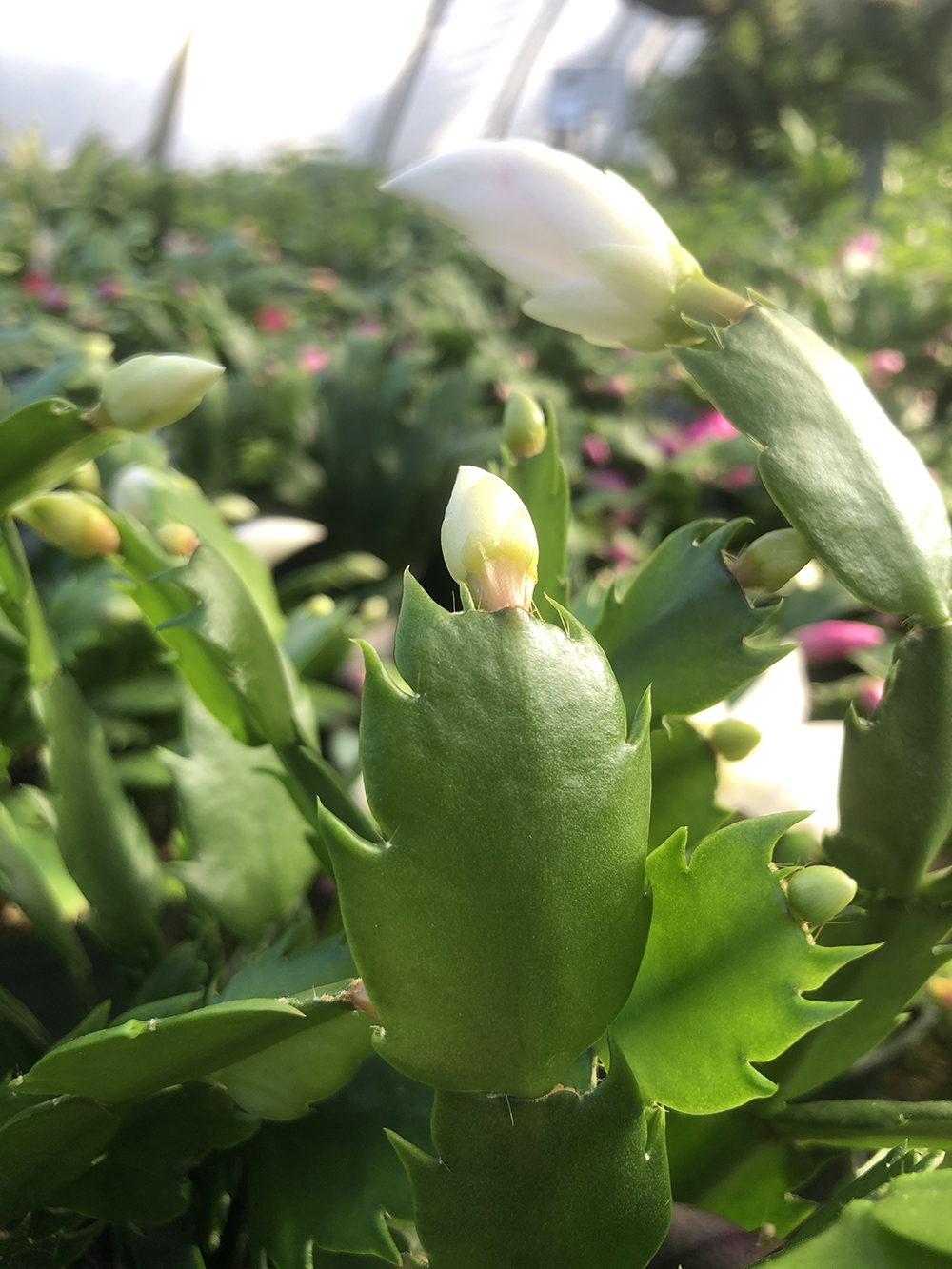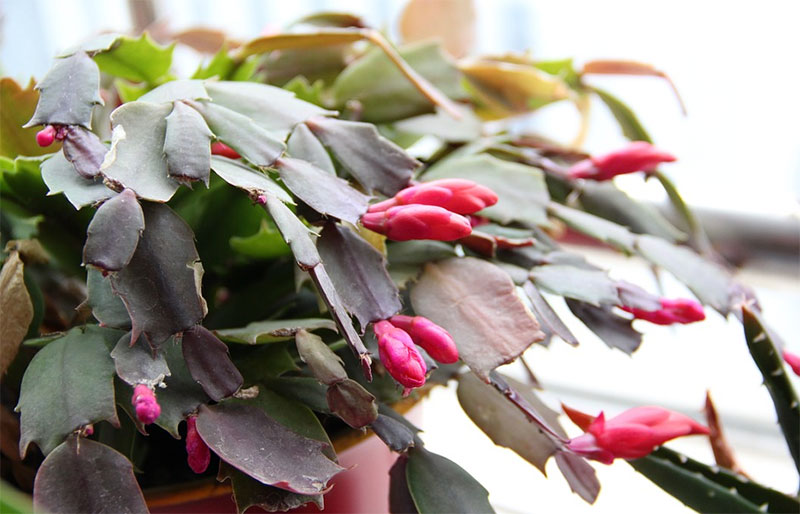
Christmas cacti lose their flower buds because to drought stress, changing temperatures, or because artificial light interferes with the 12 hours of darkness needed for flower bud development.
Christmas cacti are “short day” plants, which means they need more hours of darkness than light over a sustained period of time to develop flower buds.
It’s crucial to understand the ideal circumstances for bud creation in order to determine why Christmas cacti’s buds fall off.
This is due to the fact that bud drop is typically brought on by an abrupt shift in the environment or a major departure from the ideal developing environment.
The Perfect Environment for Christmas Cactus Flower Bud Development
Christmas cactus flower buds often appear in September.
Your flower buds must meet the parameters listed below to grow correctly:
- Starting in September, every evening for at least six weeks, there will be 12 hours or more of continuous darkness. Short-day plants like Christmas cacti need more hours of darkness than light to develop buds. This is because it has evolved to recognize seasonal changes in its surroundings, which encourage flowering.
- cooler than typical temperatures throughout the bud-formation process. In the 12 or more hours of darkness, the ideal temperature for bud formation is around 60°F (15°C). Its original Brazilian environment’s seasonal colder temperatures are simulated by this temperature change.
- The daytime energy needed for bud production is then provided to the Christmas cactus by bright indirect light. A lot of shadow might cause flower buds to fall off.
- The best moisture balance for Christmas cactus during bud formation is about once per week of watering, with intervals where the soil’s surface is dry to the touch. Keep the plant away from any strong air currents and mist it once or twice a week.
- When the flower buds are growing in the late summer, avoid applying any fertilizer. Additional fertilizer may encourage the growth of leaves rather than buds.
- a constant atmosphere without turning or moving the plant. When the buds are forming, Christmas cacti become extremely acclimated to their surroundings and dislike being moved.
If your Christmas cactus faces conditions that are different from these, this is probably the reason why the blossoms aren’t growing or are falling off.
If your buds are dropping off before they can bloom, keep reading to find out why.
(I’ve ranked the most frequent causes of bud drop at the top.)
Table of Contents
Underwatering and Low Humidity Causes Buds to Drop off
Christmas cacti are indigenous to Brazil’s mountainous jungle, where they flourish in conditions of high humidity and regular rainfall.
This stands in stark contrast to other cactus species that live in the desert and flourish in hot, arid environments with little water.
Christmas cactus flower buds will fall off as they form if the indoor humidity is too low.
Even while homes typically have low humidity, there are numerous factors that might make it worse and raise the chance of bud drop, including:
- airflow caused by air conditioning.
- fluctuating heat and forced air flow.
- Household spaces that are drafty.
- Conventional currents brought induced by wintertime heat sources.
Try to place your cactus in a part of the house that is mostly quiet (although moving the plant during bud formation is not advised).
Use a spray mist on the leaves two or three times each week to combat these reasons of low humidity and to replicate the ecosystem of the cactus rainforest habitat.
This makes it easier for the Christmas cactus to develop its flowers and lessens water loss (transpiration) from the leaves, which helps to lessen the effects of drought stress.
Underwatering…
The popular Christmas cactus is frequently underwatered, which leads to drought stress and negatively affects the development of bloom buds. This is because people equate cacti with drought endurance and desert conditions.
To prevent flower buds from dropping, the right watering balance is crucial.
Usually, watering once a week is sufficient to meet the cactus’ moisture needs and prevent any issues with overwatering or underwatering. This ensures that the soil is evenly moist but that the surface is dry to the touch in between bouts of watering.
(Read my post for additional information on the best watering techniques and how frequently and how much to water Christmas cacti.)
Interrupted Darkness Interferes with the Formation of Flowers

To successfully form blossoms on your Christmas cactus, there must be more darkness (more than 12 hours) than light.
Even for a brief moment, turning on a bright light in the middle of the night disrupts the period of darkness for the plant, which may result in the plant not producing flowers or the growing buds falling off.
I advise covering your Christmas cactus with a light-blocking cloth for the six weeks or so the buds are growing if it is impossible to find a room in your house that is generally dark without any artificial light for longer than 12 hours.
(For solutions if your cactus doesn’t bloom at all, read my article Why is my Christmas cactus not flowering.)
Moving the Christmas Cactus can Cause Flower buds to drop off
Relocating the cactus while the flowers are still budding is a typical error that causes bud drop.
Moving the plant may disrupt the environment that the Christmas cactus is accustomed to, which results in flower bud drop. Christmas cactus requires a rather specific sequence of conditions for flowering.
Bud drop is frequently caused by a shift in air movement as well as a difference in the light source’s direction.
The Christmas cactus prefers a constant light source as it grows its buds.
The direction of light can be changed by turning the plant or relocating it to a different window sill. In reaction, the flower buds frequently stop growing as they move toward the new source of the greatest light.
To avoid stress and stop the flower buds from falling, make sure your cactus remains in the same spot consistently starting in around September. Avoid moving it or turning it around for any reason.
Saturated Soil Causes Flower Buds to Drop
Christmas cacti are rainforest plants, but because they are epiphytic—they grow on other trees rather than on the ground—they cannot handle having their roots in wet or muddy soil.
The soil must be kept uniformly moist while still having good drainage.
Root rot, a generally droopy appearance, and dropped flower buds can all be results of excessive moisture around the roots.
There are a number of causes of wet soil that lead to buds falling off, including:
- Overwatering. Usually, watering once a week is sufficient while buds are forming.
- pots without base drainage holes. The roots of the Christmas cactus cannot withstand standing water. Make sure your pot’s base has drainage holes and that they are not blocked by compacted soil or plant roots.
- using attractive exterior pots, trays, and saucers. The bottom of the pot should have no trouble letting any extra water out. If the saucer, tray, or exterior pot collects water, the soil may remain excessively wet and the flower buds may become stressed and fall off.
In order to maintain the ideal moisture balance during bud production and prevent the flower buds from dropping off, make sure your potted Christmas cactus plants have sufficient drainage.
(Read my post Why is my Christmas cactus wilting for the answer if your Christmas cactus is significantly drooping or wilting.)
Fluctuating Temperatures

Christmas cacti are indigenous to high Brazilian rainforest locations, where they are used to cooler temperatures and shorter days for the duration of the flower buds’ development.
Aim to maintain the temperature for about 6 weeks starting in September at about 60°F (15°C). The flower buds may drop if the temperature is much different from this.
A temperature of 68°F (20°C) is thought to extend the flowering period once the blooms have developed.
Key Takeaways:
- Christmas cactus loses its flower buds due to dry stress, changing temperatures, overwatering, and an excessive amount of artificial light at night.
- For six weeks starting in September, Christmas cacti need evenly moist soil, higher humidity, and more hours of darkness than light.
- The flower buds frequently try to orient toward more light and then drop off as a sign of stress if you move the cactus during flower bud production and change the direction of the brightest light.
- When the buds are developing, keep the Christmas cactus at cooler temperatures and mist the leaves to raise the humidity.
